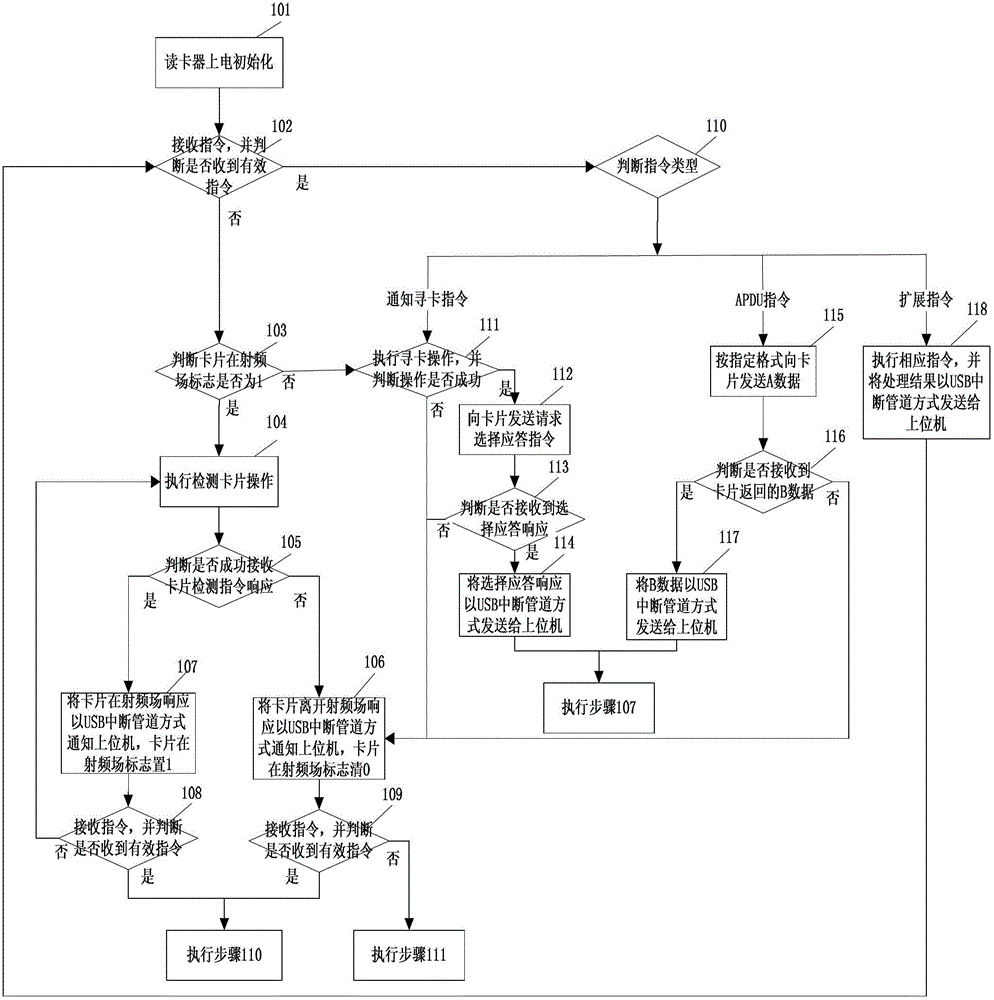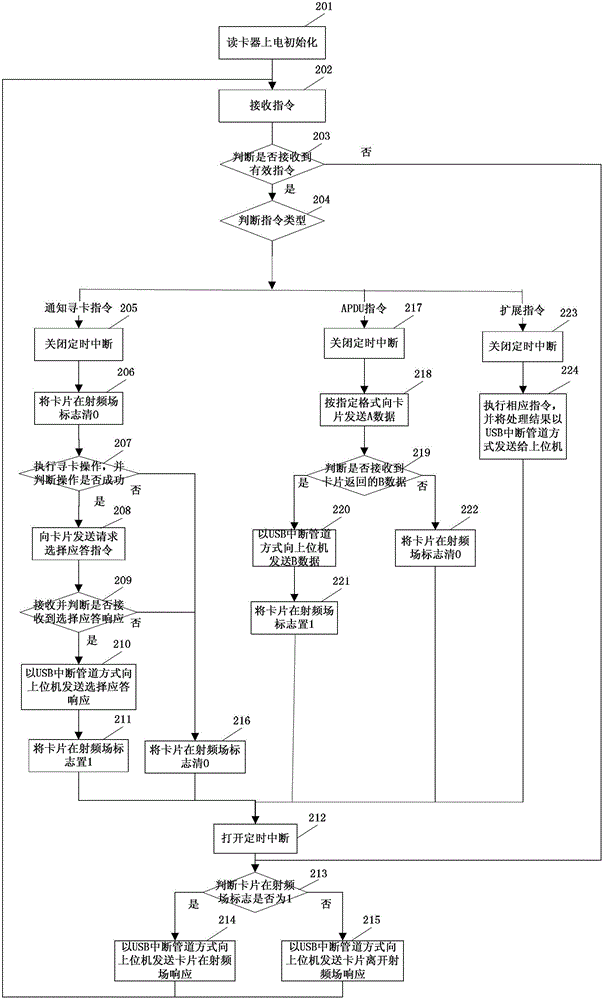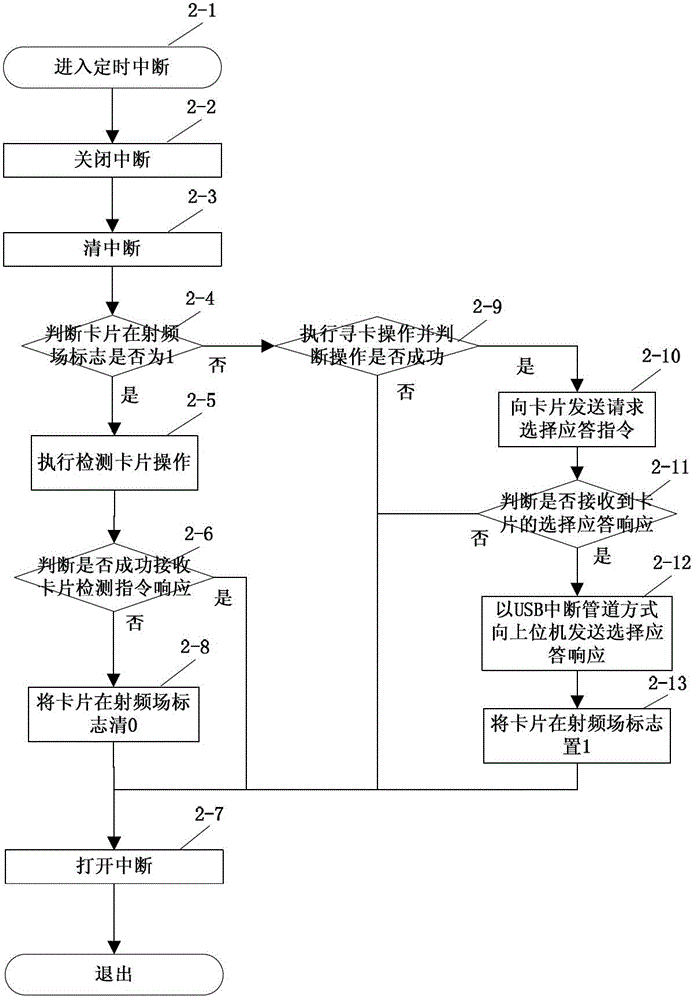Method for detecting departure of non-contact type CPU card from radio frequency field
一种非接触式、射频场的技术,应用在智能卡领域,能够解决干扰卡片操作状态等问题,达到实现检测的效果
- Summary
- Abstract
- Description
- Claims
- Application Information
AI Technical Summary
Problems solved by technology
Method used
Image
Examples
Embodiment 1
[0122] See figure 1 , Embodiment 1 provides a method for detecting that the card leaves the radio frequency field, which specifically includes:
[0123] Step 101: Power on the card reader to initialize;
[0124] In this embodiment, the card is initially marked as 0 in the radio frequency field.
[0125] Step 102: Receive an instruction, and determine whether a valid instruction is received;
[0126] If yes, go to step 110; if no, go to step 103.
[0127] In this embodiment, the card reader receives the instruction sent from the buffer in the USB interrupt pipe mode. If the first byte of the instruction is within the preset range (0x01-0x03), it means that a valid instruction has been received. For example, if the first byte of the received command is 0x01, then a valid command is received. If the card reader does not receive or the first byte of the received instruction does not meet the preset value, the received instruction is not a valid instruction.
[0128] Step 103: Determine wh...
Embodiment 2
[0249] Referring to Figures 2(1) and 2(2), Embodiment 2 provides a method for detecting the card leaving the radio frequency field, which specifically includes:
[0250] Step 201: Power-on initialization of the card reader;
[0251] Turn on timed interrupts.
[0252] In this embodiment, the card is initially marked as 0 in the radio frequency field.
[0253] Step 202: Receive an instruction;
[0254] In this embodiment, the instruction received by the card reader may be a notification card seeking instruction, APDU instruction, or extended instruction sent by the host computer.
[0255] Step 203: Determine whether a valid instruction is received;
[0256] If yes, go to step 204; if no, go to step 213.
[0257] The judgment method is the same as step 102 in the first embodiment.
[0258] Step 204: Determine the instruction type;
[0259] In this embodiment, if the first byte of the instruction received by the card reader is 0x01, which is a notification instruction for finding a card, then st...
Embodiment 3
[0383] Referring to Figures 3(1) and 3(2), Embodiment 3 provides a method for detecting the card leaving the radio frequency field, which specifically includes:
[0384] Step 301: Power on the card reader to initialize;
[0385] Open communication interruption.
[0386] In this embodiment, the instruction flag is initially 0, and the card is initially 0 in the radio frequency field.
[0387] Step 302: Determine whether the instruction flag is 1;
[0388] If yes, go to step 311; if no, go to step 303.
[0389] Step 303: Judge whether the card has a flag of 1 in the radio frequency field;
[0390] If yes, go to step 304; if no, go to step 311.
[0391] Step 304: Perform a detection card operation;
[0392] In this embodiment, the specific card detection operation is the same as step 104 in Embodiment 1.
[0393] Step 305: Determine whether the card detection command response is successfully received;
[0394] If yes, go to step 306; if no, go to step 308.
[0395] In this embodiment, the specifi...
PUM
 Login to View More
Login to View More Abstract
Description
Claims
Application Information
 Login to View More
Login to View More - R&D
- Intellectual Property
- Life Sciences
- Materials
- Tech Scout
- Unparalleled Data Quality
- Higher Quality Content
- 60% Fewer Hallucinations
Browse by: Latest US Patents, China's latest patents, Technical Efficacy Thesaurus, Application Domain, Technology Topic, Popular Technical Reports.
© 2025 PatSnap. All rights reserved.Legal|Privacy policy|Modern Slavery Act Transparency Statement|Sitemap|About US| Contact US: help@patsnap.com



